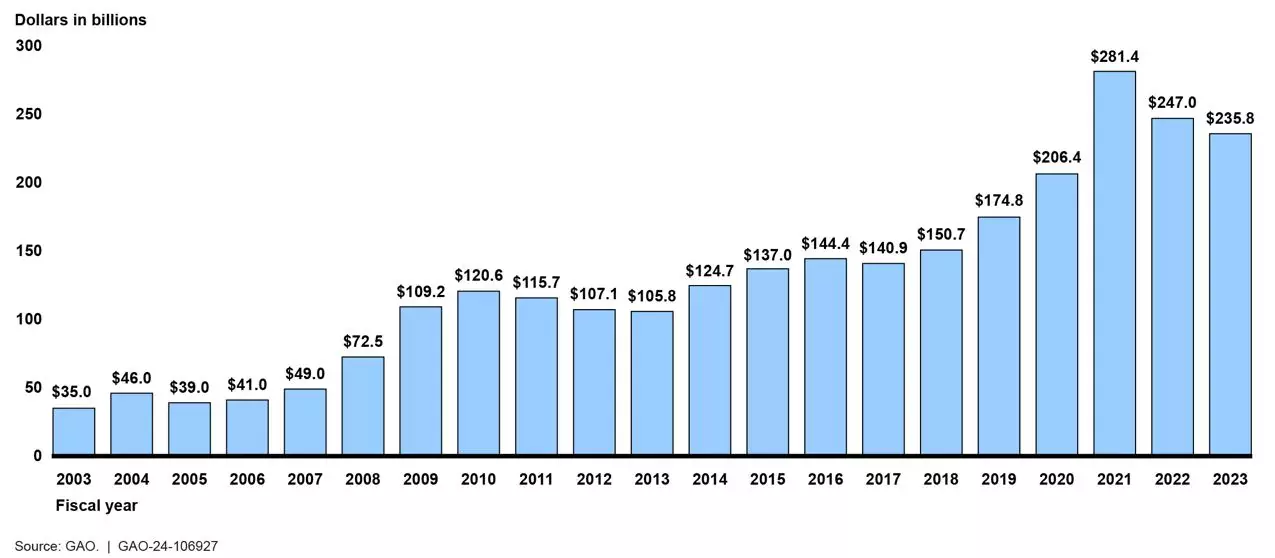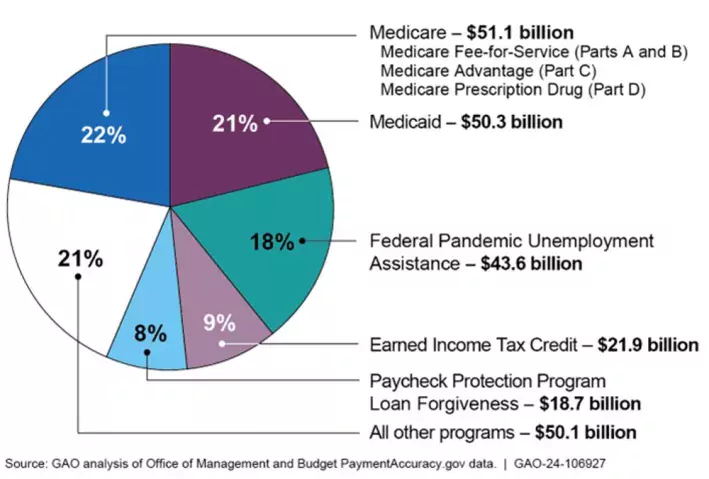Federal Government Made $236 billion “Improper Payments” Last Fiscal Year
The federal government reported an estimated $236 billion in “improper payments” during the most recently completed fiscal year (FY 2023). Such payments are essentially payment errors that can be the result of many things—including overpayments, inaccurate recordkeeping, or even fraud.
Payment errors are a long-standing issue for the federal government. Over the last 20 fiscal years, it has made an estimated $2.7 trillion in such improper payments.
What’s causing these errors and what can be done to prevent them? Today’s WatchBlog post looks at our new report, issued today.
What were the payment errors in FY 2023?
The $236 billion in improper payments were reported by 14 agencies across 71 programs.
- More than $175 billion (74%) of errors were overpayments—for example, payments to deceased individuals or those no longer eligible for government programs
- $11.5 billion were underpayments
- $44.6 billion were unknown payments—meaning it is unclear whether a payment was an error or not
- $4.6 billion were cases where a recipient was entitled to a payment, but the payment failed to follow proper statutes or regulations
Some good news: payment errors have declined since last fiscal year by about $11 billion. Eight program areas saw substantial declines in improper payments this past year. For example, payment errors under Medicaid dropped by $30 billion from the previous year. Program areas that reported substantial declines in payment errors said the decreases were due to mitigation strategies that they had implemented, among other things.
But there was also some bad news: Five programs saw substantial increases in payment errors. For example, the Department of Labor’s Pandemic Unemployment Insurance program saw an increase of $44 billion in errors.
Overall, while improper payments were down from last year, they remain higher than pre-pandemic times.
Reported Estimates of Government-wide Improper Payments Since FY 2003
Image

Which programs had the most payment errors?
About $186 billion (79%) of such errors were concentrated in five program areas: Medicare, Medicaid, Pandemic Unemployment Assistance, the Earned Income Tax Credit, and Paycheck Protection Program Loan forgiveness.
Some of these program areas have consistently been among those with the highest payment errors—including Medicaid, Medicare, and the Earned Income Tax Credit. These are also federal program areas that issue the most payments to individuals and, as a result, maybe more vulnerable to these sorts of errors.
Image

In our prior work, we’ve made recommendations to help reduce such errors. Many of these recommendations still require action from agency leaders.
For example:
- Medicare could improve communication around its prior authorization program. This program requires that beneficiaries get approval before receiving certain items like powered wheelchairs—and it could reduce expenses and improper payments.
- Medicaid could improve oversight to ensure that claims aren’t paid to ineligible medical providers, including those who have suspended or revoked medical licenses.
- Earned Income Tax Credit—The Internal Revenue Service could take steps to review more W-2s before issuing tax refunds to reduce the risk of tax refund fraud.
How can we reduce payment errors across the federal government?
Some of our recommendations to reduce improper payments under specific programs are discussed above, but there are more. GAO has made numerous recommendations to agencies and provided suggestions to Congress on ways to help reduce them. Our recommendations for federal agencies include those that would call for better monitoring of federal programs and planning that would help identify risks. For Congress, we think agencies could use help identifying susceptible programs, developing reliable methods for estimating errors, and implementing effective corrective action.
Learn more about our work on federal payment errors by checking out our latest report on improper payments.
- GAO’s fact-based, nonpartisan information helps Congress and federal agencies improve government. The WatchBlog lets us contextualize GAO’s work a little more for the public. Check out more of our posts at GAO.gov/blog.
GAO Contacts
Related Products

GAO's mission is to provide Congress with fact-based, nonpartisan information that can help improve federal government performance and ensure accountability for the benefit of the American people. GAO launched its WatchBlog in January, 2014, as part of its continuing effort to reach its audiences—Congress and the American people—where they are currently looking for information.
The blog format allows GAO to provide a little more context about its work than it can offer on its other social media platforms. Posts will tie GAO work to current events and the news; show how GAO’s work is affecting agencies or legislation; highlight reports, testimonies, and issue areas where GAO does work; and provide information about GAO itself, among other things.
Please send any feedback on GAO's WatchBlog to blog@gao.gov.




